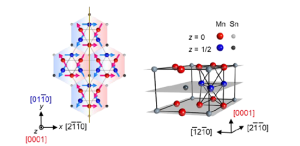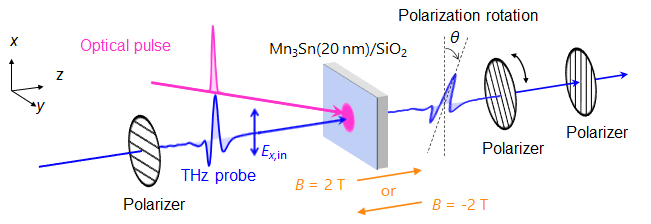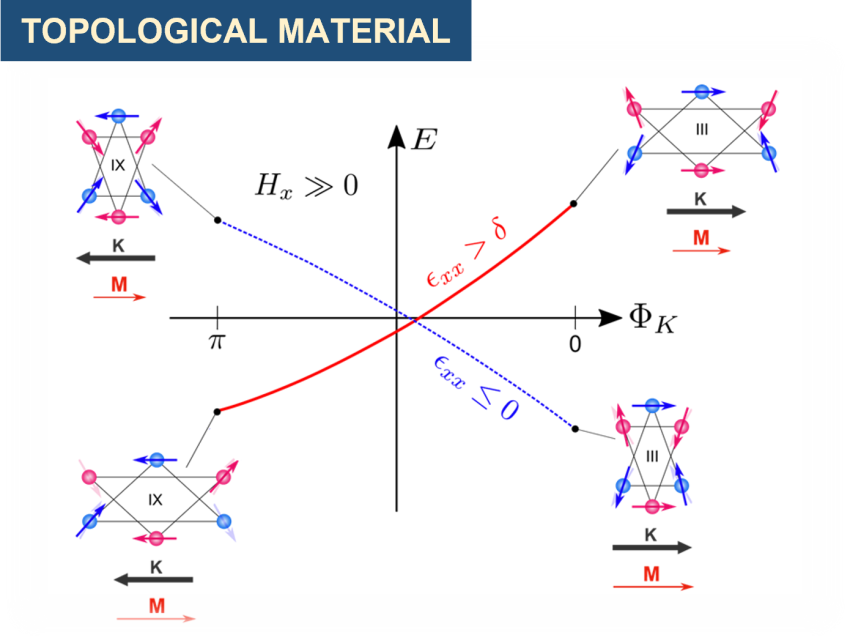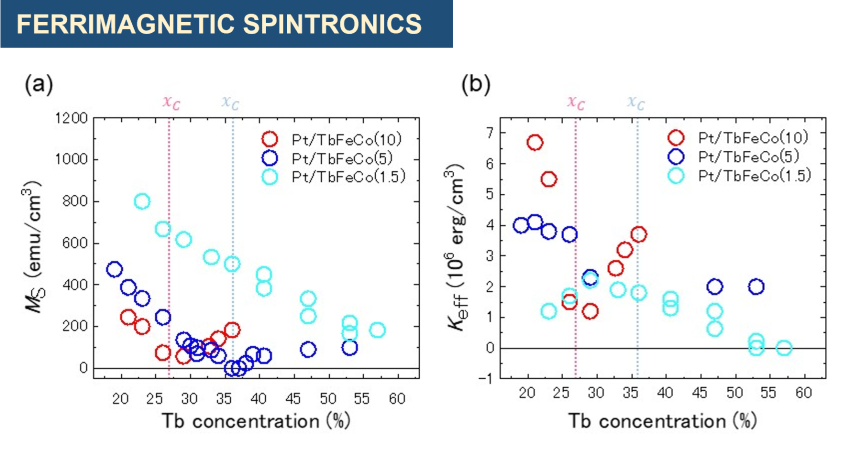Research Highlights
World-leading study of topological antiferromagnets(External Site)
 Our latest research on topological antiferromagnets and their spintronics applications are featured by JST.
Our latest research on topological antiferromagnets and their spintronics applications are featured by JST.
Ultrafast dynamics of the Anomalous Hall effect in the topological antiferromagnet Mn3Sn

The large, magnetization-free anomalous Hall effect in Mn3Sn makes the material highly promising for achieving all-antiferromagnetic memory devices with unprecedented operation speed and minimal energy consumption. Previous research using THz time-domain spectroscopy found that the ultrafast AHE in the THz-regime resembles the static AHE and is nearly dissipation-free at room temperature. This result suggests that the observed THz-scale AHE could be used for the electrical readout of high-speed magnetic memory. To realize this perspective, a sub-picosecond time-resolved investigation is necessary to clarify the origin of the ultrafast AHE and its interplay with the time evolution of the underlying magnetic order.
In the new study by Prof. Ryusuke Matsunaga’s team, the ultrafast dynamics of AHE in Mn3Sn are investigated by using ultrashort optical pulses with sub-100fs time resolution. By comparing the experimental results with microscopic calculations, the study reveals that the intrinsic Berry-curvature mechanism is responsible for the ultrafast AHE. This work demonstrates that nonequilibrium dynamics can provide essential clues to the microscopic mechanism of anomalous transport and thereby guide its application.
This work is published in Physical Review Letters.
Room-temperature tunneling magnetoresistance in an all-antiferromagnetic memory device

Magnetoresistive random access memory (MRAM) has the potential to revolutionize computer memory by offering ultrafast, high-density, and energy-saving data storage and processing. A critical step to realizing such a possibility is to improve MRAM’s operation speed and integration density; both factors are currently limited by the ferromagnetic materials used for this technology. Antiferromagnets have recently emerged as promising constituents for future ultrahigh-speed on-chip MRAM, owing to their thousandfold faster spin dynamics and lack of a stray field. However, a critical challenge to address is demonstrating the tunneling magnetoresistance (TMR) in all-antiferromagnetic MRAM, which is essential as a reading protocol.
The new study led by Prof. Satoru Nakatsuji’s research team reports the observation of a finite room-temperature TMR in all-antiferromagnetic spintronics devices comprising Mn3Sn, which breaks the common belief that TMR is directly related to interfacial spin polarization, and thus is restricted to ferromagnetic materials. This first-of-its-kind demonstration not only pushes the boundaries of operation speed in magnetic memory but also lays a firm foundation for advancing all-antiferromagnetic MRAM toward commercialization.
This work is published in Nature, and is featured Phys.org, EurekAlert!, and Utokyo FOCUS.
Large piezomagnetic effect allows strain control of antiferromagnet

Identifying effective control knobs for antiferromagnets is key to pushing forward their spintronic applications. Recent work by Professor Satoru Nakatsuji’s team, together with collaborators at Cornell and Johns Hopkins Universities in the US and the University of Birmingham in the UK, has led to the remarkable discovery of sizable piezomagnetic effect in the topological antiferromagnet Mn3Sn, famous for its nearly magnetization-free anomalous Hall effect. This piezomagnetic effect enables an applied strain as small as about 0.1% to reverse the sign of the anomalous Hall signal by rotating the underlying spin structure. The effective strain control of the anomalous Hall effect complements the conventional means, such as a magnetic field and electric current, and will be indispensable for widening the scope of topological antiferromagnetic spintronics.
This work is published in Nature Physics, and is featured in Physics World
Full electrical switching of antiferromagnet unlock unprecedent speed and capacity for spintronic devices

Spintronic applications make a great leap forward by turning to antiferromagnets. Antiferromagnetic memories are insensitive to stray fields and can operate hundreds of times faster than their ferromagnetic counterparts. These unique characteristics open the door to high-speed, high-density, and low-power data processing. A major obstacle, though, is the difficulty in controlling antiferromagnetic spin structure, which limits the device performance. Professor Satoru Nakatsuji and Project Associate Professor Tomoya Higo from the University of Tokyo, together with Dr. Kouta Kondou from RIKEN and other team members, achieved full electrical switching of the antiferromagnetic Mn3Sn for the first time, enabled by applied tensile strain. Such switching maximizes the device’s operating speed and dramatically simplifies the device configuration, setting down a vital milestone in antiferromagnetic spintronics.
This work is published in Nature, and is featured in Phys.org, EurekAlert!, and Utokyo FOCUS
Ferrimagnetic compensation and its thickness dependence in TbFeCo alloy thin films

Rare earth-transition metal (RE-TM) ferrimagnets comprise unbalanced, antiferromagnetically- coupled sublattice moments, leading to reduced net magnetization and antiferromagnetic-like spin dynamics. These combined advantages yield their potential for high-density, high-speed spintronics.
Researchers led by Professor Satoru Nakatsuji and Professor Masamitsu Hayashi at the University of Tokyo, and Dr. Kay Yakushiji at AIST investigate the magnetic properties of Tb-based RE-TM ferrimagnetic thin film. The results reveal how magnetic compensation – the key to reaching zero net magnetization –evolves with the film’s thickness and clarify the origin of perpendicular magnetic anisotropy (PMA) in these thin films, an essential property for spintronic applications. These findings offer a roadmap for leveraging the advantageous properties of ferrimagnetic thin films to achieve high-density, high-speed magnetic memory devices.
This work is published in Applied Physics Letters.
A new Si-based platform for energy-efficient optical interconnects

Adopting optical interconnects for future short-distance communications eliminates power-hungry data transfer by electrical interconnects, a promising way to cope with the ever-accelerating digital transformation. The central goal is to make optical interconnect energy efficient, which may require a “receiverless” system without electrical amplifiers.
A vital component of the “receiverless” system is a photodetector (PD) featuring low capacitance and high responsivity. To achieve this, research teams led by Professor Makoto Okano and Professor Misturu Takenaka put forward an ultrathin InGaAs membrane PD based on a Si slot waveguide with outstanding performance and a simple fabrication process. This proposed PD may bring us closer to a “receiverless” system with minimized power consumption.
This work is published in the 2022 IEEE Symposium on VLSI Technology and Circuits
Benchmark calculation for predicting antiferromagnetic structures

Realizing a large anomalous Hall effect (AHE) in an antiferromagnet with vanishingly small magnetization sounds bizarre because the AHE is commonly believed to go hand in hand with net magnetization. However, topological antiferromagnets make it happen. Such groundbreaking discovery calls for a new framework to understand antiferromagnets’ magnetic structure – the specific pattern formed by antiparallel-aligned spins. Recent research has shown that, unlike ferromagnets, the properties of antiferromagnets are properly characterized by a group of spins forming a collective magnetic moment―a cluster multipole―rather than the net magnetization. This conceptual input renders us predictive power for the antiferromagnetic structure realized in experiments.
Professor Arita’s team and collaborators perform a high-throughput calculation for nearly 3000 possible antiferromagnetic structures in 131 materials incorporating the cluster multiple theory. This new scheme yields stable and metastable magnetic structures that reproduce the experimental results well, demonstrating its power to narrow down the possible magnetic structures of antiferromagnet materials. With this approach, we make an essential step forward to build a large-scale database of antiferromagnetic materials that can guide their optimization for ultrafast spintronics.
This work is published in Physical Review X
